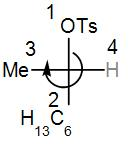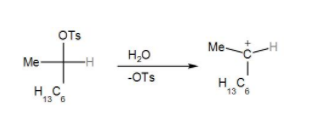
(R)-2-octyl tosylate is solvolysis in water under ideal
[A] R-2-octanol and S-2-octanol in a 1:1 ratio
[B] R-2-octanol and S-2-octanol in a 1:5 ratio
[C] R-2-octanol only
[D] S-2-octanol only
Answer
485.4k+ views
HINT: To solve this, remember that
COMPLETE STEP BY STEP SOLUTION: Before answering this question, let us discuss what

We can see that the least priority group is in horizontal position and thus the above structures in R-absolute configuration. Now, let us see its solvolysis via

Here, we can see that a planar carbocation is formed. So, the nucleophile can attack from any side and thus inversion as well as retention can take place here. Inversion will give us the S-product and retention will give us the R-product. So, we can write the mechanism as-

We will get the R as well as the S product in equal amounts.
Therefore, the correct answer is option [A] R-2-octanol and S-2-octanol in a 1:1 ratio
NOTE: We can describe the mechanism of

Then, the nucleophile (Nu) attacks the carbocation and gives us the product.

The reactivity of compounds undergoing
- The first factor is the effectiveness of the removal of the leaving group.
- The second factor is whether or not the carbocation formed is stable.
COMPLETE STEP BY STEP SOLUTION: Before answering this question, let us discuss what

We can see that the least priority group is in horizontal position and thus the above structures in R-absolute configuration. Now, let us see its solvolysis via

Here, we can see that a planar carbocation is formed. So, the nucleophile can attack from any side and thus inversion as well as retention can take place here. Inversion will give us the S-product and retention will give us the R-product. So, we can write the mechanism as-

We will get the R as well as the S product in equal amounts.
Therefore, the correct answer is option [A] R-2-octanol and S-2-octanol in a 1:1 ratio
NOTE: We can describe the mechanism of

Then, the nucleophile (Nu) attacks the carbocation and gives us the product.

The reactivity of compounds undergoing
- The first factor is the effectiveness of the removal of the leaving group.
- The second factor is whether or not the carbocation formed is stable.
Latest Vedantu courses for you
Grade 11 Science PCM | CBSE | SCHOOL | English
CBSE (2025-26)
School Full course for CBSE students
₹41,848 per year
Recently Updated Pages
Master Class 9 General Knowledge: Engaging Questions & Answers for Success

Master Class 9 English: Engaging Questions & Answers for Success

Master Class 9 Science: Engaging Questions & Answers for Success

Master Class 9 Social Science: Engaging Questions & Answers for Success

Master Class 9 Maths: Engaging Questions & Answers for Success

Class 9 Question and Answer - Your Ultimate Solutions Guide

Trending doubts
Give 10 examples of unisexual and bisexual flowers

Draw a labelled sketch of the human eye class 12 physics CBSE

Differentiate between homogeneous and heterogeneous class 12 chemistry CBSE

Differentiate between insitu conservation and exsitu class 12 biology CBSE

What are the major means of transport Explain each class 12 social science CBSE

What is the difference between resemblance and sem class 12 social science CBSE




